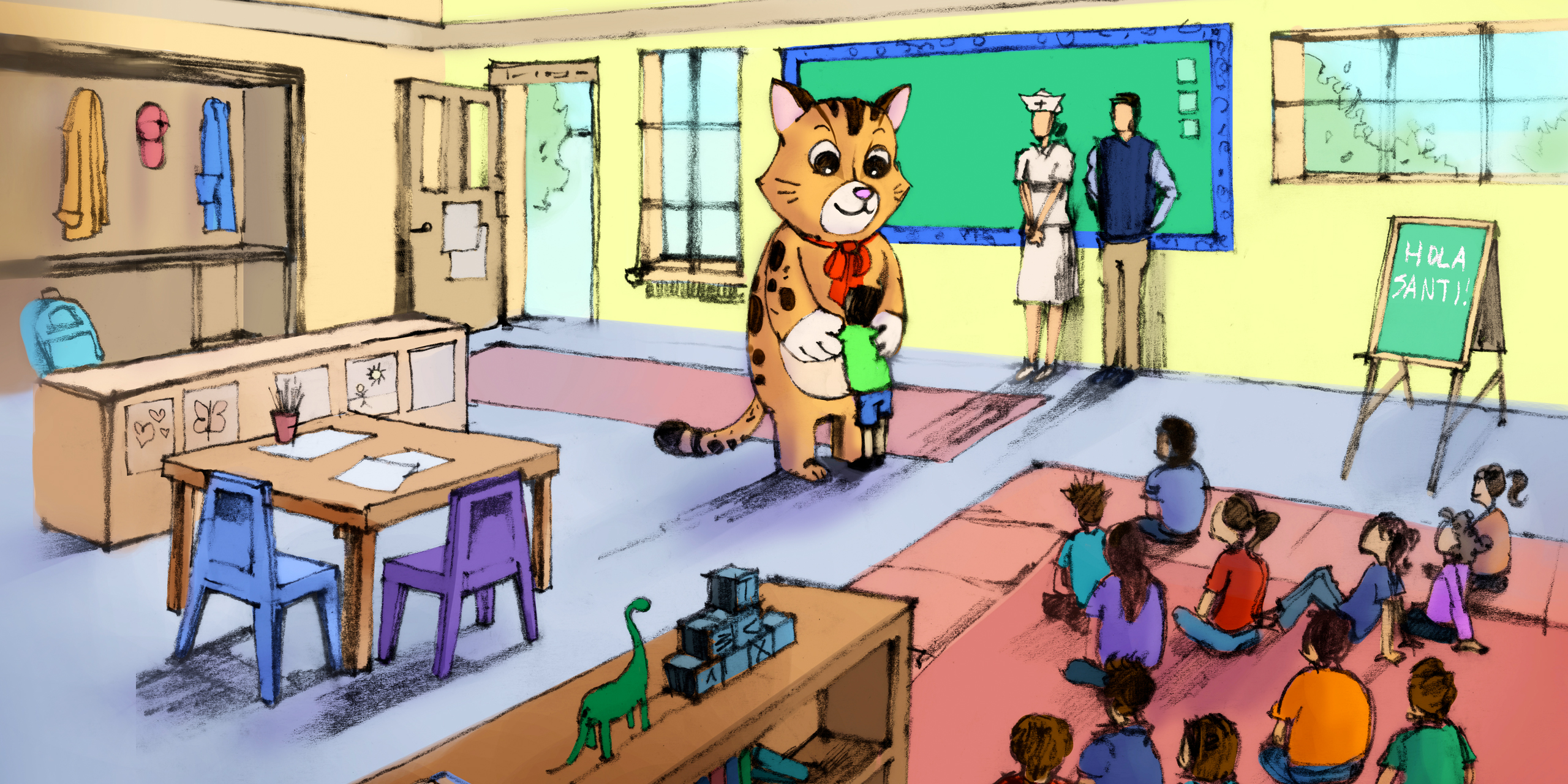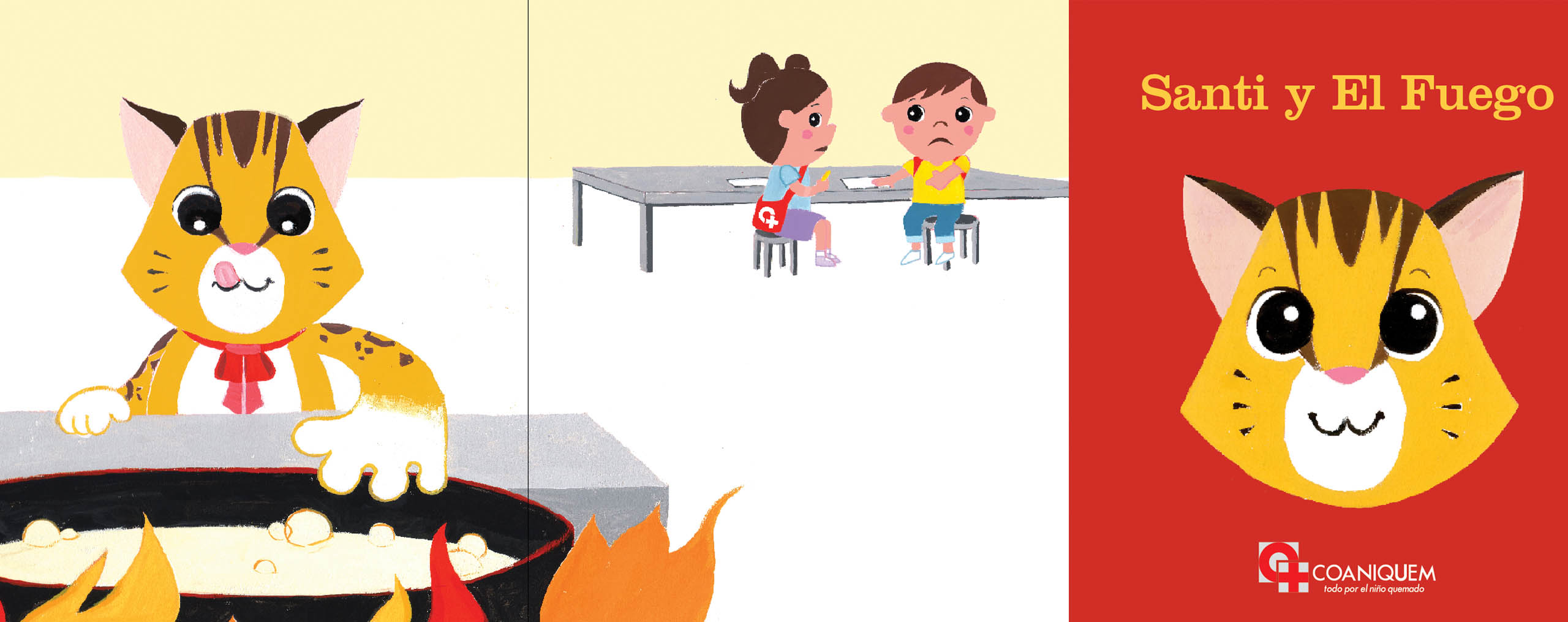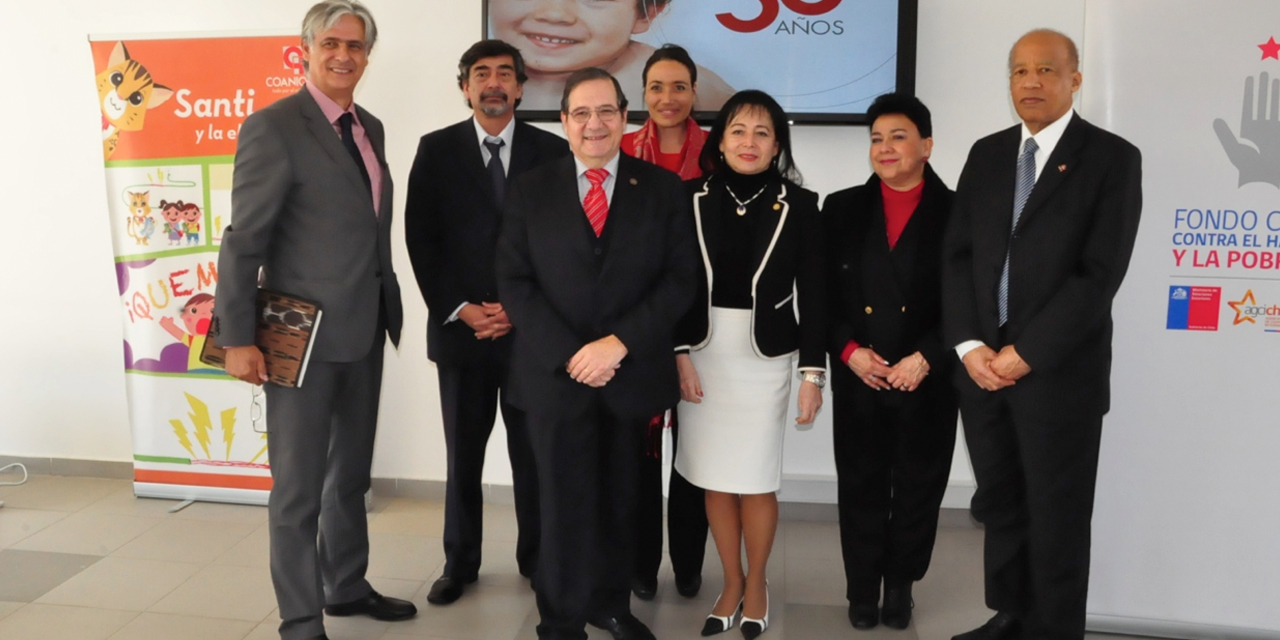Santi Y La Plancha
As a cuddly friend and teacher, Santi the cat—the burn prevention mascot of Coaniquem—helps children stay safe.

Spring 2013
Students in this spring 2013 TDS applied their multi-departmental skills to create a global campaign with a twofold focus: to develop positive burn prevention messages, and to increase awareness and support for children burn victims.
Since the studio’s conclusion in 2013, COANIQUEM has integrated Santi the mascot as an iconic prevention character in its brand and communications in comprehensive ways. Most recently Santi was a key inspiration for the ArtCenter students in the Safe Ninos studio who evolved his story in impactful ways that are being now implemented throughout COANIQUEM’s campus in Pudahuel.

With this campaign, a new door opens for Coaniquem, one that lets us continue to make the changes we started and to continue to help the children. We’ve never had a campaign before that had multiple possibilities of graphics, animation, a mascot and all the symbols of Coaniquem that this class expressed, and did so with our emotion and our hope.
– Dr. Jorge Rojas, Zegers Founder/Executive President, Coaniquem
Burn accidents across Latin America reach upwards of 7 million children per year. In Chile, that number is 100,000, with the majority being children under 5 years of age.
Within Chile, burn accidents are the third cause of death in children under fifteen years of age, which represents 15% of the population. 90% of the burn accidents occur at home in the presence of adults and are caused by: hot liquids, open fires, electrical fires, and hot elements such as heaters and irons. Though they are small in size, the damage they do is quite large.
The first part of the healing process after a burn accident is a one-month stay in the hospital, the second part is a 20-year process of healing, and that’s where Coaniquem comes in. Coaniquem is a non-profit institution created by Dr. Jorge Rojas in 1979 to help children suffering from devastating and life altering burn injuries. Today, Coaniquem is the leading humanitarian children’s organization in South America working to bring medical attention, restorative healing and comprehensive rehabilitation to 8,000 of the most seriously injured children due to burns. It does this completely free of charge, to all children under 15 years of age, providing living quarters for the children who have to live there, as well as to one of their parents. Additionally, Coaniquem works as a leader in progressive research around burn injuries.
At the Coaniquem Center, a generation of medical professionals is being trained including: doctors, registered nurses, physical therapists, occupational therapists, psychologists, social workers and music therapists. A school at the center allows for the continued education of the children who are there. Together, these elements contribute to the holistic rehabilitation of 100,000 children across Latin America. Despite the severity of the injuries and long rehabilitative path ahead, the Coaniquem environment is one where joy is present and a positive environment prevails, as day by day children regain more and more of their lives.
Coaniquem doesn’t just work with burned children, they work with families and communities, too, helping them accept the children so they won’t live a life that’s defined by their scars.
– Carolyn Scheutz, Director/Treasurer, COANIQUEM BCF, US Foundation
Guillaume Wolf of the Graphic Design department led this transdisciplinary studio, partnering with Coaniquem. Working closely with the founding physician of the center, students created a new global campaign that targeted greater burn prevention awareness for children. While a global audience was the target audience, the campaign specifically focused on six Central American countries that stood to benefit the most from positive prevention messages and stronger global awareness.
The process of furthering the Coaniquem project was an organic one, adhering to the belief that a free flow of ideas, open exchange of information and ongoing collaboration allows challenges to be met efficiently and for forward momentum to be maintained.

It’s not about me saying, ‘Here’s what to do,’ it’s about all of us deciding, ‘What can we do together?’ We take information, we put it into action and then we flow with it; it’s fast and it’s dynamic.
– Guillaume Wolf, Instructor, Graphic Design
As early as week one, the class was putting ideas together based on the their initial data. That data was expanded and the project’s focus was developed in week two when Coaniquem founder, Dr. Jorge Rojas traveled from Chile to make presentations with the U.S. Foundation secretary/treasurer, Carolyn Scheutz. Insights gleaned through the students’ interactions with Rojas and Scheutz pushed the project forward.
Weeks two through six saw the development of a Coaniquem mascot. With most burns occurring in children under two years of age, the campaign needed to be impactful to a non-literate audience and so, the mascot became a primary tool for the campaign for children. As the class narrowed choices down to three characters, they began the development of three character narratives, while creating multiple, visual character explorations. Ultimately, the cat, “Santi,” (short for Santiago) was chosen and the process of rendering him in 3D began. Later, the class decided to create a mascot form that a person would wear to interact with children in the centers.
Short books were envisioned, and their narratives required integrating the new mascot into age appropriate plot lines. It was decided that each story’s central narrative constraint would revolve around two children teaching Santi, the cat, to stay away from things that are hot. Simple images would be used to tell and resolve the story, which would be text-free with the exception of one word: Caliente! (Hot!) In addition to discussing the books’ narrative structure, the students analyzed it in terms of what typeface would be most compelling to children.
The onset of a social media component emerged in week four as the students and instructor filmed short clips with the intention of potentially gathering momentum on social media sites. Concurrently, the class engaged in analysis of brochures, flyers, pamphlets and other print material, which were aimed at a target group of US donors. Students designed large, friendly and approachable postcards for mailers, and a bookmark with a red ribbon as an incentive for potential donors. For brochures, the students chose bright colors to represent a brighter future. Cover concept discussions centered around using the word “you” as a powerful way to capture attention. Pocket-sized brochures were requested by the client to be used when out in the field. With many options open to philanthropists, the focus of these brochures was to encourage donors to commit to the long term support that is necessary for a burned child’s rehabilitation.
The class put into development three other elements for the Coaniquem campaign: a motion animation piece based on the books being developed, an educational song and educational packets for distribution at schools and centers, which are described below.
The students honed their vision and moved the campaign development forward. Within thirteen weeks they were able to deliver a robust and exciting set of materials for Coaniqeum, targeting both children at risk and the US-based communities who could further support the organization’s efforts.
Being part of a Designmatters class was a humbling experience for me…humbling to be asked to join a team of designers to design for impact and change, to design with designers that come from different backgrounds in the arts, and to become united to make a difference in people’s lives. As an artist one of my number one aspiration is to connect to other human beings; what a better way to actually do so than by making a difference in someone’s life? Designmatters gave me that opportunity.
– Fatima Ghanavi, Student, Graphic Design
1. The Mascot: Santi, the mischievous cat. Cross-cultural, relatable and universal, Santi is used across all the platforms. Two physical mascot costumes were created in order to animate Santi in his interaction with children at the Coaniquem centers.
2. The Stories: As an effective way to teach children about the dangers of hot things, five children’s picture books were written. Painted in Gouache, a child friendly medium, all the stories feature children as heroes who guide Santi throughout. The stories have the same format: they start with children having innocent fun together, they progress to Santi getting too close to something hot, and they conclude with the children saving the day. Only one word is ever spoken: “Caliente!” (Hot!); it is always the climax, which is resolved by the kids taking away the dangerous element. The decision to ”save” Santi from touching anything hot empowers children reading the books with regard to how they can maintain their own safety.
Each of the five books addressed focus on the leading causes of burns:
3. The Activity Book: Full of activities that are created around safe scenarios in the form of: mazes, connect the dots, coloring sections with the safe scenes. All reinforce what dangerous objects not to touch. Upon completion of the book, children receive stickers of completion.
4. The Education Packet: To be distributed at rehab centers and local schools, it includes: the five books, a DVD of the animated stories, a pack of activity books, gold medal stickers for children, a gold medal for Santi. Teachers and nurses receiving the education packets engage children in fun, burn-prevention activities and discussions. When children learn what not to touch, Santi himself comes in to give the children a “live” opportunity to warn Santi of the dangers of hot objects. At the end of their time with Santi, they’ll have a picture taken with Santi to keep and share. Beyond playing a part in individual children’s lives, Santi also becomes the symbol of the wisdom all children can have around burn prevention, as well as being the mascot for the organization which supports burned children.
5. Santi the Doll. A way for children to learn via play and to reinforce the message that Santi is the Coaniqeum mascot around burn prevention.
6. Santi Day. In a proposed community fair, information is distributed, with all proceeds of sales from Santi dolls going to support Coaniquem.
7. The Instagram Campaign. A modern way for Santi to play hide and seek via an Instagram, a photo-based social network platform. Here, the user takes the picture and posts it online for the world to see immediately. Using Santi, as the face of this “Find Santi” Instagram campaign, creates broad awareness.
8. The Print Campaign: Educating the public about burn prevention and the work of Coaniquem is accomplished through two campaign posters: The Santi posters, for children, and the Esperanza posters, for donors. Placed in public places, like: buses, bus stops, museums, they create public awareness and invite people to donate to Coaniquem.
9. The Animation Campaign: Motion pieces reinforce the message to children regarding the danger of hot things. These run approximately 1-minute and are made out of images from the books.
10. The Large Brochure: To be distributed to those who will be approached for donations, the girl pictured on the cover is holding a sign with the message: “Burned children need your help. (But this is not for everyone.)” Inside, a letter, is written from the perspective of Dr. Rojas, Coaniquem’s founding physician.
11. The Small Brochure: Designed to be distributed at fundraising events, it translates material from the large brochure into a compact, pocket-sized format.
12. The Bookmark: Giveaways contain information to spread awareness, and as a gift to potential donors, feature the Coaniquem logo on a ribbon.
13. The Postcard: As part of a mass-mailing donor cultivation campaign, the postcards are meant to share information on Coaniquem and how to donate: via mail or through the website.
14. The Song. Two students wrote an educational and fun song about Santi, that can be a part of live events with the Santi mascot.
15. The Branding Style Guide: Created to act as a guideline for Coaniquem, the style guide walks them through the brand, showcasing how to utilize the different elements of the system and the campaign, for the organization’s future rollout and expansion.
Coaniquem has shown me how the smallest changes in getting people what they need can change their lives.
– Lisa Wakiyama, Student, Illustration/Entertainment Design
The Coaniquem “Santi” Campaign has been presented at major events such as the 2014 Lollapalooza Chile Music Festival. Coaniquem also procured support from the Chile Fund Against Hunger and Poverty, a joint initiative of the Government of Chile, through the Ministry of Foreign Affairs and International Cooperation Agency (AGCI) – and the Programme of the United Nations Development Programme (UNDP) for further campaign implementation and to also continue their work in Costa Rica, El Salvador, Guatemala and the Dominican Republic. In 2015, Coaniquem rolled out a large scale initiative entitled “Colegios Por Coaniquem – CXC” which is focused on engaging children of all age groups in burn prevention education by actively involving them in volunteering and fundraising programs.

Pictured from Lft to Rt: Antonio Molpeceres: UN Development Programme (UNDP) Resident Representative in Chile, Ricardo Herrera: Executive Director of AGCI, Dr Jorge Rojas Zegers: President of COANIQUEM, Ana Elena Pinto: Economic Affairs – Embassy of Costa Rica, Gisela Godinez: Guatemalan Ambassador, Marta Isabel Ramos: Minister-Counselor – Embassy of El Salvador, Pablo Mariñez: Dominican Republic Ambassador